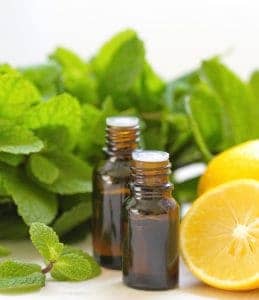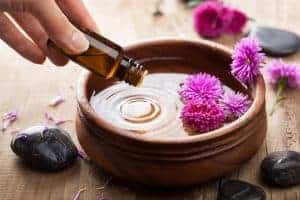A big part of the appeal of essential oils is their simplicity.
Using the pure essence of a plant to replace some of the chemical-laden solutions with dozens of ingredients stocked at the local grocery sounds delightfully simple.
So what is it, exactly, that you pay for when you buy essential oil? What distinguishes one brand from the next?

A “simple” search for essential oils can get complicated fast. There are tons of options on the market, and prices can vary a lot.
It’s not always easy to know exactly what’s inside any given essential oil bottle, but there are a few questions you should be asking before you buy.
How Was The Oil Extracted?
Many essential oil producers get their product out of a plant these days with a chemical solvent called hexane.
Hexane is a gas obtained in the process of refining petroleum.
In high concentrations, such as those you’d find in an industrial setting, it can be dangerous. It’s highly flammable, and it comes with a bevy of warnings from the Centers for Disease Control about its health effects, such as irritation of the skin and stomach. If people breathe in too much hexane, they can experience dizziness, headaches, nausea and even unconsciousness.
When it comes to extracting oil, though, hexane gets the job done very effectively. In addition to extracting oil from leaves and flowers, it’s commonly used to extract oil from seeds and beans, such as from sunflower seeds and soybeans for their respective oils.
Manufacturers remove hexane from food products after it’s used for extraction, but studies have found that residual amounts of hexane often remain in the final food products.
The Food and Drug Administration generally doesn’t check for or limit the amount of hexane in most foods, although the CDC limits the amount of hexane workers should be exposed to each day. It’s generally considered safe to ingest in small quantities.
But as it happens, there are many other ways to extract essential oils that don’t involve toxic gas and preserve more of the plant’s ideal qualities.
Cold Pressed
One common extraction method for essential oils is cold pressing or “expression,” which basically means squeezing the plant material without the use of heat until the plant’s natural oils comes out.
In this oil extraction process, the desired plant material may be ground up and mixed into a paste, then pressed down with such force that oil is produced and separated from the remaining plant material. Applying this force requires special machinery such as hydraulic presses.
Some cooking or carrier oils are made using this type of cold pressed process, as opposed to using solvents or adding heat to extract the oils. The temperature maintained during this pressing process can have an effect on the outcome, too. The less heat applied, the higher the quality of the resulting oil.
Citrus essential oils are often made in this way by cold pressing the fragrant rinds until their essence is released.
Steam Distilled
Another way to extract essential oil is through steam distillation.
We like the way the blog Sciencing sums it up: “Steam distillation is performed by bubbling hot steam through the mixture to be distilled, and collecting the vapor that results.” The collected vapor then condenses into the desired product in distinct layers that can be separated.
Often producing essential oil is the focus of steam distillation, but the scented water byproduct, known as a hydrosol, is also sought after in the case of many flowers, herbs, or plant materials like lavender, rose, chamomile, lemon balm, rosemary, and even sandalwood.
Essentially, different elements within the same plant have different temperatures at which they are released. Although bringing the mixture to a boil would ruin some of the substance’s desired properties, using steam can achieve the goal of oil extraction at lower temperatures.
More fragile substances require lower heat and pressure, and this steam distilling process requires great care.
There are also a few other methods of extracting oils without the use of chemicals, like CO2 extraction, or enfleurage but they are relatively rare.
How Were the Source Plants Farmed?
The qualities of the essential oils you use are a direct result of the plants that they came from.
If they were grown using standard agricultural practices, that means that pesticides and chemical fertilizers played a role in their life cycle. Trace amounts of those chemicals are often present on the resulting plant, which means they can also be in the essential oils that are extracted from them.
Choosing to buy essential oils that are certified organic means choosing oils that were grown under conditions that are free of pesticides, herbicides, and chemical fertilizers.
Regulating bodies like the U.S. Department of Agriculture in the U.S. have a detailed set of standards in place about the soil conditions and chemical fertilizers that cannot be used for any food product officially labeled “USDA Organic.”
Note that a simple reference to the word “organic” on a label without the official USDA organic logo does not imply that the oil meets the same stringent certifications.
Is the Oil Lab-Tested?
Your essential oil will have gone through a long journey by the time it ends up in your cabinet.
It generally takes a great deal of plant material to make just one small bottle of oil. The plants that went into that bottle may have been grown in various regions, under various climates and times of year, and with different growing methods.
Oil companies can carefully vet their suppliers to try to ensure that they are using the best quality plants. However, sometimes the easiest way to check to make sure that oils have the correct properties and organic chemical proportions is to run samples through a laboratory analysis.
Labs that are dedicated to testing essential oils can tell essential oil producers exactly which compounds are present in any given batch.
In many cases, that means that labs can verify that the correct botanical species were used to make the oil, and that the right plant compounds are present in the right range. Some labs check for specific contaminants or allergens.
If your oil producer works with a lab to verify the purity of their oil samples, they’ll probably say so on their website or label, but you can also ask directly.
Is It Too Good to be True?
In the U.S., there’s not yet a standard quality certification process for essential oils. Their production is mostly unregulated.
It’s possible for marketers to upload their oils to sell on sites like Amazon and claim that their oils are “organic,” “100% pure,” “natural,” “healing,” and “therapeutic,” or any number of claims without any verifiable meaning or evidence behind them.
Despite this, smart consumers can figure out whether companies’ claims are likely legitimate.
Now that you understand more about how essential oils are produced, you’ll have a better idea of what to look for. Check out producers’ websites and pay attention to how they describe the way their oils are sourced, extracted, and tested. Read their stories, and check out product reviews from essential oil experts.
Cold pressed and steam distilled organic oils cost more than their solvent-extracted, industrial-farmed counterparts. It takes a lot of effort to produce oils this way, and the result is a superior quality product. However, we’ve seen products for sale online that would be impossible to produce in a pure, undiluted manner at the prices listed.
If you see a great deal on top quality oils that seems a little too good to be true, it probably is. Remember that a single set of essential oils can last many years. In many cases, recipes call for just a few drops for any purpose. Doing your research before you get locked in to using poor quality oils is definitely worthwhile.
At Sally’s Organics, we offer a selection of laboratory tested, USDA certified organic, cold pressed or steam distilled essential oils, hydrosols, and carrier oils along with quality glassware that’s ideal for essential oil storage and applications.
Sally’s Organics is named after my grandmother Sally, who knew how to be smart about selecting organically produced, ethically sourced, effective products. To learn more about our products, contact us through this form or check out our store on Amazon.
